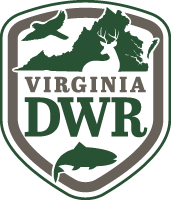(Kinosternon baurii)
Characteristics
The striped mud turtle has an olive brown to almost black carapace (upper shell). Maximum carapace length in VA is 123mm. It reaches the northern extent of its range in southeastern Virginia. In the southern part of its range, there are usually three light stripes on the carapace. However, the stripes are lacking in the northern portion of its range, which includes Virginia. Maximum plastron (lower shell) length in Virginia is 116mm and is olive to mahogany in color, sometimes with a darker outline around the scutes. Skin is dark with 2 distinctive yellowish stripes on each side of the head that extend from the tip of the nose to the side of the neck, one above and one below the tympanum (“ear”). The lower jaw is slightly curved. Females are slightly larger than males. Males have a noticeably larger tail. Courtship and mating occurs in the spring with nesting from July to early October. The female lays one to four eggs that hatch in three to four months. Striped mud turtles are active from March (late) through October in Virginia. They are aquatic turtles but spend a lot of time on land though they are not baskers. Referred to as “bottom walkers”, they forage by walking along the muddy bottom of the waterway looking for seeds from plants, insects, mollusks, and algae. They hibernate out of water buried under leaf litter in moist soil. They will try to bite when handled.
Distribution
This turtle is found on the coastal plain of Virginia as far north as the Middle Peninsula.
Foods
K. baurii is an omnivore, and eats leaves and plant seeds, algae, snails, insects, and dead fish.
The Virginia Department of Wildlife Resources Species Profile Database serves as a repository of information for Virginia’s fish and wildlife species. The database is managed and curated by the Wildlife Information and Environmental Services (WIES) program. Species profile data, distribution information, and photography is generated by the Virginia Department of Wildlife Resources, State and Federal agencies, Collection Permittees, and other trusted partners. This product is not suitable for legal, engineering, or surveying use. The Virginia Department of Wildlife Resources does not accept responsibility for any missing data, inaccuracies, or other errors which may exist. In accordance with the terms of service for this product, you agree to this disclaimer.

